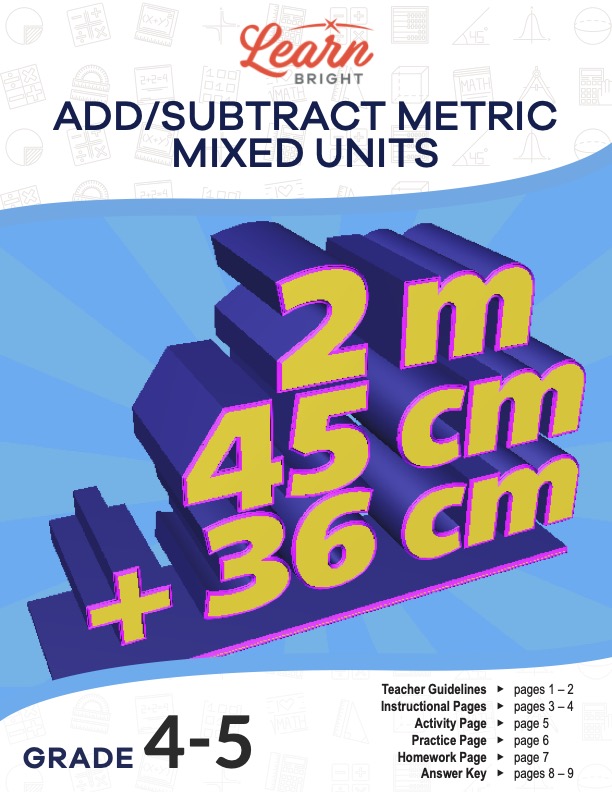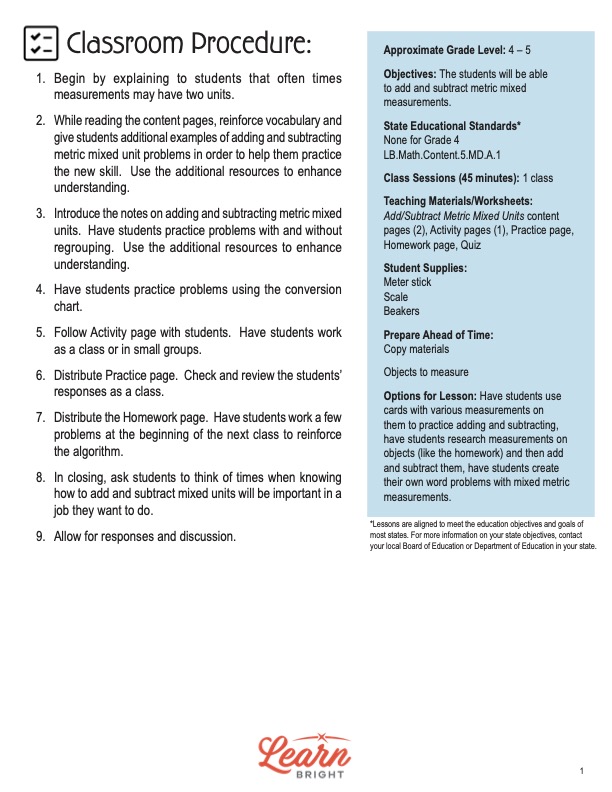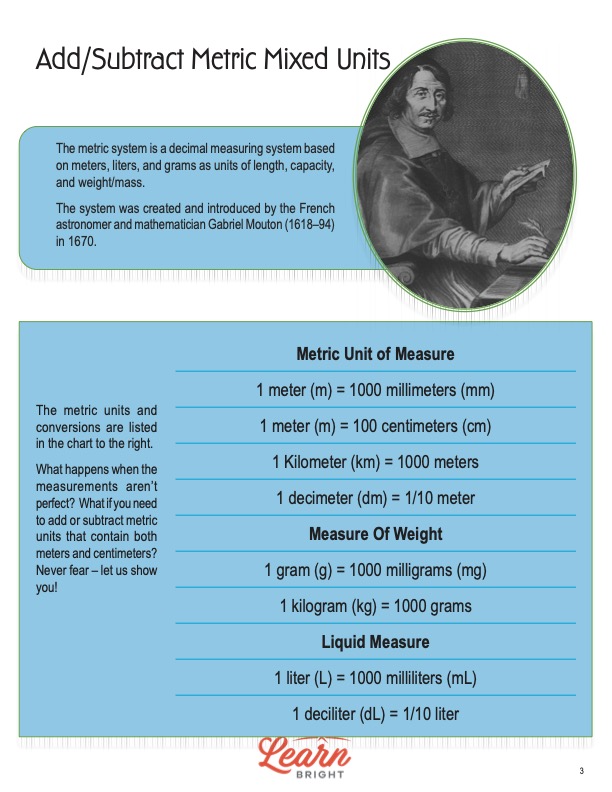Description
What our Add-Subtract Metric Mixed Units lesson plan includes
Lesson Objectives and Overview: Add-Subtract Metric Mixed Units teaches students how to add and subtract measurements that have different metric units. The metric system is the measurement system most commonly used outside the United States, but it’s important for students to be familiar with it. By the end of the lesson, students will be able to convert between different units of measurement. This lesson is for students in 4th grade and 5th grade.
Classroom Procedure
Every lesson plan provides you with a classroom procedure page that outlines a step-by-step guide to follow. You do not have to follow the guide exactly. The guide helps you organize the lesson and details when to hand out worksheets. It also lists information in the blue box that you might find useful. You will find the lesson objectives, state standards, and number of class sessions the lesson should take to complete in this area. In addition, it describes the supplies you will need as well as what and how you need to prepare beforehand. The supplies you will need for this lesson include meter sticks, scales, and beakers.
Options for Lesson
Included with this lesson is an “Options for Lesson” section that lists a number of suggestions for activities to add to the lesson or substitutions for the ones already in the lesson. One optional addition to this lesson is to have students use cards with various measurements on them to practice adding and subtracting. You can also have students research measurements on objects (like the homework) and then add and subtract them. Finally, have students create their own word problems with mixed metric measurements.
Teacher Notes
The teacher notes page includes lines that you can use to add your own notes as you’re preparing for this lesson.
ADD-SUBTRACT METRIC MIXED UNITS LESSON PLAN CONTENT PAGES
Add/Subtract Metric Mixed Units
The Add-Subtract Metric Mixed Units lesson plan includes three content pages. The metric system of measurement is a decimal measuring system based on meters (length), liters (capacity), and grams (weight/mass). French astronomer and mathematician Gabriel Mouton (1618-94) created the system in 1670.
The lesson lists different metric units of measure and their conversions as a helpful chart, split into three parts: metric unit of measure, measure of weight, and liquid measure. It includes, for example, that 1 meter (m) = 1000 millimeters (mm).
But what happens when you need to add or subtract metric units that contain both meters and centimeters? We call these mixed metric units. The lesson includes several examples to show students how to solve these problems.
In the first example, we want to add 2m 45cm + 36cm. To solve, you first need to line up the units from largest to smallest and add the corresponding measurements. In this example, you’ll add meters with meters and centimeters with centimeters. First, add the meters: 2 + 0 = 2. Then, the centimeters: 45 + 36 = 81. Therefore, your final answer is 2m 81cm.
The lesson includes a second example where we want to add 3 m 62cm + 1m 50cm. We follow the same steps as the first problem. First, add the meters: 3 + 1 = 4. Then, add the centimeters: 62 + 50 = 112. 100cm = 1m, so we convert the centimeters into meters. 112 cm = 1m 12cm, so our final answer is 5m 12cm.
You can also regroup subtraction problems with two units, like in the example problem: 7L 150mL = 3L 600mL. Like with addition, you line up the units from largest to smallest and subtract the corresponding measurements. For this problem, you subtract liters and milliliters. We need to borrow 1L to create 1000mL before subtracting. Subtract the liters: 6L – 3L = 3L. Then subtract the milliliters: 1150 mL – 600mL = 550mL. Our final answer is 3L 550mL.
ADD-SUBTRACT MIXED METRIC UNITS LESSON PLAN WORKSHEETS
The Add-Subtract Metric Mixed Units lesson plan includes four worksheets: an activity worksheet, a practice worksheet, a homework assignment, and a quiz. You can refer to the guide on the classroom procedure page to determine when to hand out each worksheet.
MEASURING OBJECTS ACTIVITY WORKSHEET
The activity worksheet asks students to measure the length of objects, the amount of liquids, and the weight of objects and then add and subtract various combinations of each type of measurement.
FIND THE ANSWER PRACTICE WORKSHEET
For the practice worksheet, students will solve ten problems by adding or subtracting.
ADD-SUBTRACT METRIC MIXED UNITS HOMEWORK ASSIGNMENT
The practice worksheet asks students to solve six problems using the approximate ship lengths listed on the first page of the worksheet.
QUIZ
This lesson also includes a quiz that you can use to test students’ understanding of the lesson material. For the quiz, students will solve two problems that require them to add or subtract mixed metric units.
Worksheet Answer Keys
This lesson plan includes answer keys for the practice worksheet, the homework assignment, and the quiz. If you choose to administer the lesson pages to your students via PDF, you will need to save a new file that omits these pages. Otherwise, you can simply print out the applicable pages and keep these as reference for yourself when grading assignments.









